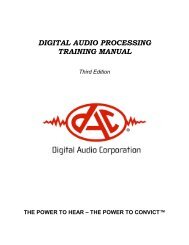QuickEnhance® VST User's Manual - Digital Audio Corporation
QuickEnhance® VST User's Manual - Digital Audio Corporation
QuickEnhance® VST User's Manual - Digital Audio Corporation
Create successful ePaper yourself
Turn your PDF publications into a flip-book with our unique Google optimized e-Paper software.
5.5.3 <strong>Audio</strong> clarification procedures<br />
The primary purpose of reducing background noise is to be able to hear<br />
what is being said – voice intelligibility. If we plan to use the enhanced<br />
tape in court or other legal proceedings, the voice on the tape must also<br />
“sound” like the person. This could limit what we can do to process the<br />
audio. Remember, the adaptive filter can reduce time-correlated noise<br />
within the voice frequency bandwidth and not affect the voice. But what<br />
if there are random noises still present which mask the conversation? If<br />
these noise signals extend across the entire bandwidth (broadband<br />
noise), there is little we can do. However, if they are limited in their<br />
frequency range(s), we might be able to do something.<br />
Suppose that there is some random noise between 3000–3500 Hz that is<br />
so loud we can not hear the conversation. We could use either a notch<br />
filter or a band-stop filter to reduce the loud noise in this frequency<br />
band. The result may be that the noise level is reduced and we can hear<br />
what is being said. However, the voice energy would be modified within<br />
this frequency band so it probably would not “sound” the same as the<br />
person normally does. Thus, in this case we would have to find the<br />
proper balance when adjusting the filters so that we achieve both<br />
maximum intelligibility and maximum voice quality.<br />
In conclusion, this primer has provided an introduction to audio<br />
enhancement and noise filtering for beginners. There are other filters<br />
and many techniques and processes that were not covered here. To<br />
learn more details on audio enhancement, you are encouraged to attend<br />
DAC School.<br />
27
















